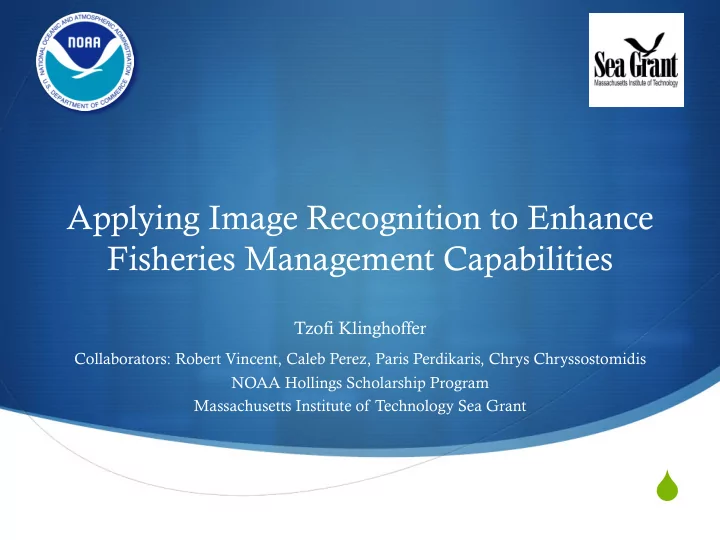

Applying Image Recognition to Enhance Fisheries Management Capabilities Tzofi Klinghoffer Collaborators: Robert Vincent, Caleb Perez, Paris Perdikaris, Chrys Chryssostomidis NOAA Hollings Scholarship Program Massachusetts Institute of Technology Sea Grant S
How Many Herring?
Image Recognition Solution: 6 herring found in 0.01 seconds
Today’s Presentation S Objective S Background S Current Technique S Applying Image Recognition S Results S Conclusion S Future Work S References
Objective S To automate the detection and counting of relevant fisheries species in image and video data through image recognition S Relevant fisheries species: Atlantic Sea Flatfish, such as Various round Skates Alewife Herring /Blue Scallops flounder fish species (Rajidae) Back Herring (Pleuronectiformes) (Placopecten ( Alosa pseudoharengu s / magellanicus) Alosa aestivalis)
Background “ The world’s finest wilderness lies beneath the waves … ” — Robert Wyland, Marine Life Artist S Fisheries populations have a large impact on the U.S. economy S The U.S. fishing industry contributes about $90 billion and 1.5 million jobs to the U.S. economy [4] S In 2014, 17% of the U.S. fisheries were classified as overfished [4] S Therefore, NOAA Fisheries Management is interested in monitoring relevant species populations
Current Technique: Gather 1. Gather [underwater photographs] S Habitat Mapping Camera System (HabCam)
Current Technique: Manually Annotate 2. Manually Annotate [underwater photographs]
Current Technique: Extrapolate 3. Extrapolate [population estimates] [1] Chang et al. 2017
Applying Image Recognition S Can image recognition be used to accurately detect and count fisheries species? S How many iterations of training are needed to yield accurate results? S How does the quality of annotations used in training impact accuracy?
Appling Image Recognition: Convolutional Neural Networks S Loosely based on biological neural networks [3]
Applying Image Recognition: Methodology – Gather & annotate
Applying Image Recognition: Methodology – Train Train YOLOv2 Real-Time Object Detection algorithm: Adjusted training set: 5,063 images Original training set: 5,063 images
Applying Image Recognition: Methodology – Test Run trained YOLOv2 algorithm on 300 test images S False positives? S False negatives?
Results: Metrics S Intersection Over Union (IOU) ( % ) S Recall ( % ) recall = 𝑢𝑞/𝑢𝑞 + 𝑔𝑜 S Precision ( % ) precision = 𝑢𝑞/𝑢𝑞 + 𝑔𝑞 = 𝑢𝑞/𝑜
Results S Can image recognition be used to accurately detect and count marine species?
Results S How many iterations of training are needed to yield accurate results? ~2000
Results S How does the quality of annotations used in training impact accuracy? IOU values averaged across all objects (N = 489) in both the adjusted and original training sets.
Conclusion Image recognition is a viable solution to detecting and counting fisheries S species in photographic data You Only Look Once (YOLO) v2: Real-Time Object Detection software can S obtain as high as 93% average recall According to [2] Chang et al. 2016, imperfect automated annotation can be S combined with human annotation We recommend annotation guidelines be strictly followed S Deliverables: training sets, trained weights, programs for counting fisheries S species Implications: NOAA Fisheries can use these techniques to optimize time and resource S allocation
Future Work S Continue applying image recognition to herring S Of interest to: NOAA Fisheries, state agencies, as well as regional fisheries councils and local municipalities S Image recognition is a novel approach S Develop graphical user interface for end users S Test other image recognition algorithms, such as Faster R- CNN and Mask R-CNN
References S [1] Chang, Jui ‐ Han, Burton V. Shank, and Deborah R. Hart. "A comparison of methods to estimate abundance and biomass from belt transect surveys." Limnology and Oceanography: Methods 15.5 (2017): 480-494. S [2] Chang, Jui-Han, et al. "Combining imperfect automated annotations of underwater images with human annotations to obtain precise and unbiased population estimates." Methods in Oceanography 17 (2016): 169-186. S [3] Karpathy A. Convolutional Neural Networks (CNNs / ConvNets). In: Stanford University [Internet]. [cited 21 Jul 2017]. Available: http://cs231n.github.io/convolutional-networks/ S [4] Kearney, Melissa S., Benjamin H. Harris, and Brad Hershbein. "Economic Contributions of the U.S. Fishing Industry." Brookings . Brookings, 28 July 2016. Web. 25 July 2017. S [5] Redmon, Joseph, and Ali Farhadi. "YOLO9000: better, faster, stronger." arXiv preprint arXiv:1612.08242 (2016) . APA
Recommend
More recommend